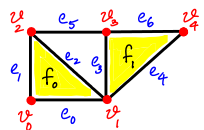A common tool in computing reduced homology groups is boundary matrices.
Boundary Matrix
Let be a simplicial complex with -simplices and -simplices . The p-th boundary matrix, , of is the matrix defined by
The above definition is when working with the underlying group of . When working over , the non-zero entries are depending on the orientations. For now we work over . For example, consider the complex below:

Then the 0-th boundary matrix is
and the 1-st boundary matrix would be
Notice that a -chain is just a sum of columns and a -chain is a sum of rows. Boundary matrices get their name as they are the matrix representation of the boundary homomorphism. That is, if is a -chain over , then is given by the matrix-vector product .
As a result, the columns of generate the -chain group . Likewise, the rows of generate . We can make use of boundary matrices to get generators of the boundary and cycle groups and .
Smith Normal Form
Smith Normal Form
A matrix is in Smith normal form (SNF) if is of the form
where with , and .
When working over , we get that , the identity matrix.
The structure of the SNF of the boundary matrix tells us the rank of and .

For example,
implying that and .
Even more, the SNF is of the form
where is the product of elementary row operations and is the product of elementary column operations. The last columns of encode a basis for and the first columns of encode a basis for .
If we keep track of the row and column operations as we go, the labels for the last three columns are , , . These 1-cycles form a basis for .
SNF Algorithm over
Algorithm 1 Smith normal form of
procedure Reduce()
if then
for do
if then
end if
end for
for do
if then
end if
end for
Reduce()
end if
end procedure